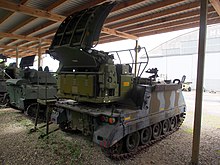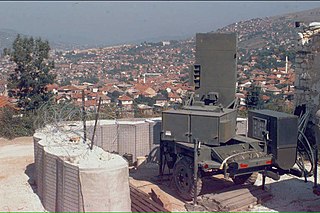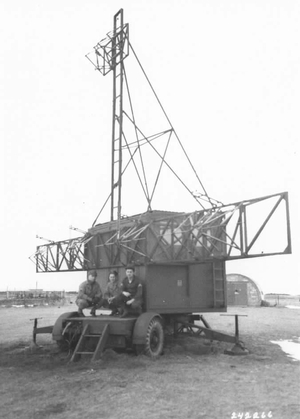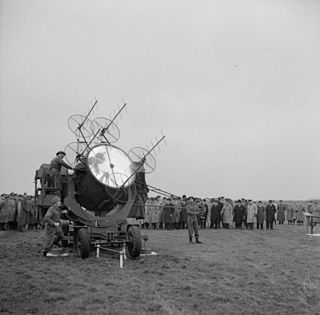Other Users

In addition to the UK, Green Archer was used by the armies of Germany, the Netherlands and Denmark (all self-propelled, mounted on an M-113 chassis), Italy, Israel, South Africa, Sweden, and Switzerland. [8]
Green Archer, also called Radar, Field Artillery, No 8 was a widely used British mortar locating radar operating in the X band using a Foster scanner. Developed by EMI after an experimental model by the Royal Radar Establishment, it was in British service from 1962 until 1975 with the Royal Artillery. [1] A self-propelled version was designated FV436 or Radar, FA, No 8 Mk 2. It was replaced by Cymbeline starting in 1975.
Mortars, using indirect fire, became a major threat to infantry in World War II. It was found that mortar bombs in flight could be detected and tracked by radar. US and UK anti-aircraft radars were used and specialised mortar locating radars appeared at the end of the war, and were used in Korea with varying degrees of success. Hostile mortars had to be accurately located before they could be attacked with indirect fire from guns or mortars. Since hostile mortars moved frequently to avoid return fire it was essential to have a means of locating them to a few tens of metres of accuracy and to be able to respond quickly when they are located.
Previous radar systems used parabolic reflectors or similar systems to produce a narrow beam of radio energy rather like a flashlight beam. This beam was then swung around the sky by moving the entire reflector, with returns, or blips, appearing on the displays when an object was caught in the beam. For tracking mortar shells this was a particularly difficult task, requiring the operator to have the antenna pointed in roughly the right location by estimates based on previous rounds, and then following the shell through its trajectory. Finding was made a bit easier if the beam cone had a large angle, the problem with this was that it reduced the accuracy of location.
The key advance in tracking mortar shells was the Foster scanner, a type of radar antenna. Instead of producing a beam of radio energy, the Foster scanner produced a fan (pie-slice shape). In the case of the Green Archer, the scanner was built in a manner to produce a beam that was less than 1° wide, but rapidly scanned across a 40° wide band in front of the radar. Any object in the scanner's view would appear on the display each time the beam crossed its horizontal bearing. To measure the vertical angle, some other system was required.
Green Archer solved this problem by quickly moving the antenna between two set vertical angles. The scanner was first set so it scanned back and forth near the horizon line. When a mortar shell was seen on the display, the operator used a grease pencil to mark its location. He then pressed a button that quickly raised the scanner so it was pointed at a higher vertical angle. This happened rapidly enough that the bomb would take some time to reach this higher altitude, at which point it would appear on the display again and this second location would also be marked. The operator them placed cursors over the marks and input the plot to the radar's analogue computer.
These two plots, the time between them and the angle between the two beam positions gave two points on a parabolic curve. Such a curve is defined by two points and is a good approximation of a mortar bomb trajectory. Using these, the azimuth of the radar beam centre and the radar's coordinates, the mortar position coordinates were calculated. These could be adjusted to reflect the actual height of the ground.
Green Archer comprised two units each mounted on a four-wheel trailer with levelling jacks, one unit was the complete radar, the other a fully silenced generator inaudible at 200 m to permit operation in forward areas. The radar unit weighed 2,915 kg and with the antenna in the operating position was 2.9 m high. The radar display was positioned up to about 15 metres from the radar and had a built in simulator for training. Each radar and generator was usually towed by a Humber 1 ton armoured vehicle, or the FV610 version of the Saracen six-wheel armoured vehicle. Each radar section was supported by an electronic repair vehicle which carried a spare for each of the 13 major sub-assemblies in each radar. [2]
Green Archer could locate a medium mortar up to about 10 km away and a heavy mortar out to 17 km, the maximum range. It took about 30 seconds from a mortar firing to producing its location. The radar could also be used "in reverse" to observe and adjust mortar fall of shot and that of guns firing in high angle. It was also capable of surface observation. [3]
In British service it was mostly organised as a radar section of two radars in the locating (G) troop of field regiments. In addition to the radars the section also had a command post and deployed two Listening Posts (LPs). The task of the LPs was to report mortars firing and the area they were in. This told the radar to switch-on, and so avoided continuous transmission as an electronic counter measure. The other section of the troop provided an artillery intelligence section at brigade headquarters responsible for fighting the brigade’s counter-mortar battle.
British Green Archers were successfully used on operations in Borneo, South Arabia and Oman against mortars and for border surveillance in Hong Kong.
A self-propelled version was fully developed. It was mounted on the cutaway rear of FV432 APC and designated FV436 or Radar, FA, No 8 Mk 2. It had an automatic radar levelling arrangement using mercury, which was adopted for the Radar, FA No 15 Mk 2, or Cymbeline that replaced Green Archer. However, it did not enter UK service. Nevertheless, the cutaway hull design was applied to M113 APCs and used by at least three armies. [4] [5]
Raytheon made a similar radar, the AN-MPQ-501 1958 001, as used by the Canadian army. [6] [7]

In addition to the UK, Green Archer was used by the armies of Germany, the Netherlands and Denmark (all self-propelled, mounted on an M-113 chassis), Italy, Israel, South Africa, Sweden, and Switzerland. [8]
A complete system, a radar trailer and a generator trailer, is preserved at the Radar Museum at RAF Neatishead in Norfolk. An M113 mounted Green archer can be seen in the artillery museum in Varde/Denmark. A radar trailer is complete with all computer units in the South Yorkshire Transport Museum in Rotherham.
Counter-battery fire is a battlefield tactic employed to defeat the enemy's indirect fire elements, including their target acquisition, as well as their command and control components. Counter-battery arrangements and responsibilities vary between nations but involve target acquisition, planning and control, and counter-fire. Counter-battery fire rose to prominence in World War I.

A counter-battery radar is a radar system that detects artillery projectiles fired by one or more guns, howitzers, mortars or rocket launchers and, from their trajectories, locates the position on the ground of the weapon that fired it. Such radars are a subclass of the wider class of target acquisition radars.

The AN/MPQ-64 Sentinel is an X-band electronically steered pulse-Doppler 3D radar system used to alert and cue Short Range Air Defense (SHORAD) weapons to the locations of hostile targets approaching their front line forces. It is currently produced by Raytheon Missiles & Defense.

The Muckleburgh Collection is a military museum sited on a former military camp at Weybourne, on the North Norfolk coast, England. It was opened to the public in 1988 and is the largest privately owned military museum in the United Kingdom.

The SCR-584 was an automatic-tracking microwave radar developed by the MIT Radiation Laboratory during World War II. It was one of the most advanced ground-based radars of its era, and became one of the primary gun laying radars used worldwide well into the 1950s. A trailer-mounted mobile version was the SCR-784.

The FV430 series covers a number of armoured fighting vehicles of the British Army, all built on the same chassis. The most common is the FV432 armoured personnel carrier.

Hughes AN/TPQ-36 Firefinder weapon locating system is a mobile radar system developed in the mid-late 1970s by Hughes Aircraft Company and manufactured by Northrop Grumman and ThalesRaytheonSystems, achieving initial operational capability in May 1982. The system is a "weapon-locating radar", designed to detect and track incoming mortar, artillery and rocket fire to determine the point of origin for counter-battery fire. It is currently in service at battalion and higher levels in the United States Army, United States Marine Corps, Australian Army, Portuguese Army, Turkish Army, and the Armed Forces of Ukraine.

Hughes AN/TPQ-37 Firefinder Weapon Locating System is a mobile radar system developed in the late 1970s by Hughes Aircraft Company, achieving Initial Operational Capability in 1980 and full deployment in 1984. Currently manufactured by ThalesRaytheonSystems, the system is a long-range version of "weapon-locating radar", designed to detect and track incoming artillery and rocket fire to determine the point of origin for counter-battery fire. It is currently in service at brigade and higher levels in the United States Army and by other countries. The radar is trailer-mounted and towed by a 2+1⁄3-short-ton (2,100 kg) truck. A typical AN/TPQ-37 system consists of the Antenna-Transceiver Group, Command Shelter and 60 kW Generator.

ARTHUR is a counter-battery radar system originally developed jointly for and in close co-operation with the Norwegian and Swedish armed forces by Ericsson Microwave Systems in both Sweden and Norway. It is also used by the British Army, under the names mobile artillery monitoring battlefield radar or mobile artillery monitoring battlefield asset (MAMBA).

The Iowa-class battleships are the most heavily armed gunships the United States Navy has ever put to sea, due to the continual development of their onboard weaponry. The first Iowa-class ship was laid down in June 1940; in their World War II configuration, each of the Iowa-class battleships had a main battery of 16-inch (406 mm) guns that could hit targets nearly 20 statute miles (32 km) away with a variety of artillery shells designed for anti-ship or bombardment work. The secondary battery of 5-inch (127 mm) guns could hit targets nearly 9 statute miles (14 km) away with solid projectiles or proximity fuzed shells, and was effective in an anti-aircraft role as well. Each of the four battleships carried a wide array of 20 mm and 40 mm anti-aircraft guns for defense against enemy aircraft.

The Swathi weapon locating radar is a mobile artillery-locating, phased array radar developed by India. This counter-battery radar is designed to detect and track incoming artillery and rocket fire to determine the point of origin for counter-battery fire.

Radar, Field Artillery, No 15, better known as Cymbeline, was a widely used British mortar locating radar operating in the I band using a Foster scanner. Developed by Thorn-EMI and built at their now-defunct site at Hayes in Middlesex, it was in British service from 1975 until about 2003 with the Royal Artillery.

The Foster scanner, or Variable Path scanner, is a type of radar system that produces a narrow beam that rapidly scans an area in front of it. Foster scanners were widely used in post-World War II radar systems used for artillery and mortar spotting. Modern radars in this role normally use electronic scanning in place of a Foster scanner for this purpose.

Radar, Gun Laying, Mark I, or GL Mk. I for short, was an early radar system developed by the British Army to provide range information to associated anti-aircraft artillery. There were two upgrades to the same basic system, GL/EF and GL Mk. II, both of which added the ability to accurately determine bearing and elevation.

Radar, Gun Laying, Mark III, or GL Mk. III for short, was a radar system used by the British Army to directly guide, or lay, anti-aircraft artillery (AA). The GL Mk. III was not a single radar, but a family of related designs that saw constant improvement during and after World War II. These were renamed shortly after their introduction in late 1942, becoming the Radar, AA, No. 3, and often paired with an early warning radar, the AA No. 4, which was also produced in several models.

The Radar Set AN/MPQ-4 was a US Army counter-battery radar primarily used to find the location of enemy mortars and larger artillery in a secondary role. Built by General Electric, it first entered service in 1958, replacing the earlier and much simpler AN/MPQ-10. The MPQ-4 could determine the location of an enemy mortar in as little as 20 seconds by observing a single round, whereas the MPQ-10 required several rounds to be launched and could take 4 to 5 minutes to take a "fix". The MPQ-4 remained one of the primary US counter-battery systems through the late 1970s until it was replaced by passive electronically scanned array radars like the AN/TPQ-36.

25 Field Artillery Regiment was an artillery regiment of the South African Artillery.

24 Field Artillery Regiment was an artillery regiment of the South African Artillery.

Searchlight Control, SLC for short but nicknamed "Elsie", was a British Army VHF-band radar system that provided aiming guidance to an attached searchlight. By combining a searchlight with a radar, the radar did not have to be particularly accurate, it only had to be good enough to get the searchlight beam on the target. Once the target was lit, normal optical instruments could be used to guide the associated anti-aircraft artillery. This allowed the radar to be much smaller, simpler and less expensive than a system with enough accuracy to directly aim the guns, like the large and complex GL Mk. II radar. In 1943 the system was officially designated Radar, AA, No. 2, although this name is rarely used.
Radar, Anti-Aircraft Number 4 Mark 7, or AA No.4 Mk.7 for short, was a mobile medium-range tactical control radar used by the British Army. It was intended to rapidly scan the sky and quickly indicate targets that could then be handed off to anti-aircraft artillery batteries who would then aim their own gun laying radars like the AA No. 3 Mk. 7 using the image provided from the No. 4 on a remote Adjacent Display (AD) unit. The Mk.7/1 added support for IFF Mark X, and the Mk.7/2 was modified for use with surface-to-air missiles.